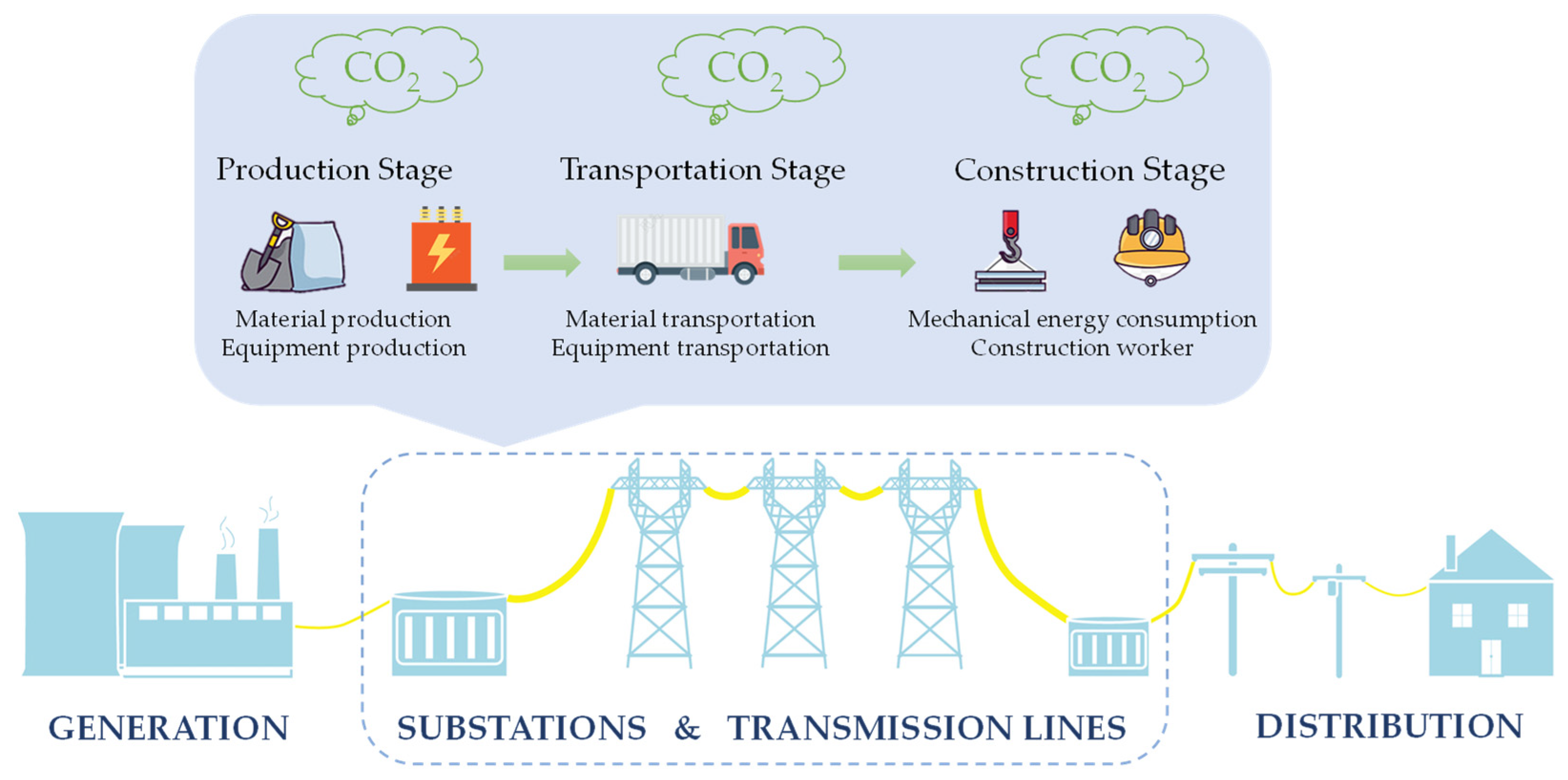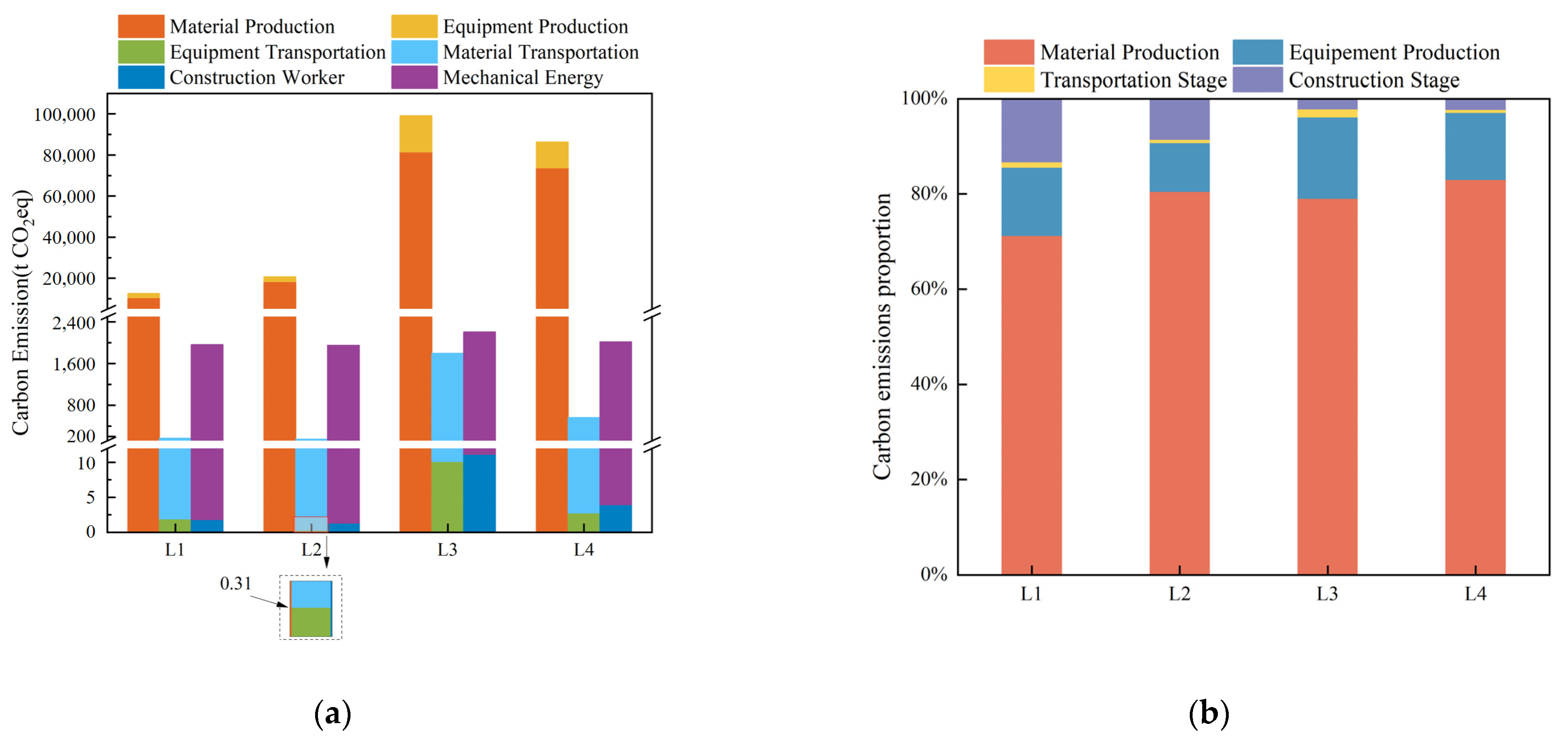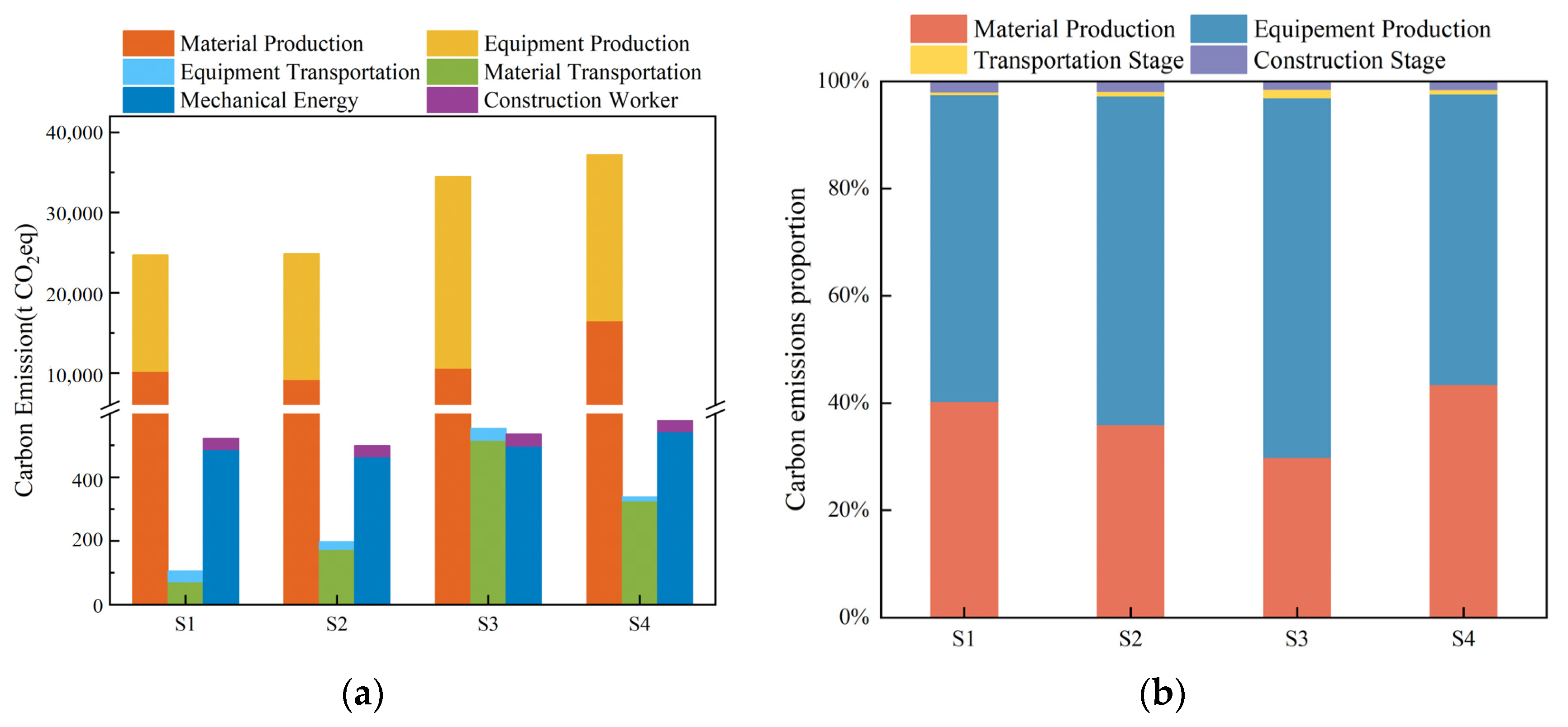Carbon Emission Accounting during the Construction of Typical 500 kV Power Transmissions and Substations Using the Carbon Emission Factor Approach
Abstract
1. Introduction
2. Carbon Emission Accounting Method
2.1. Carbon Emission Calculation Boundary
- Production stage: the production of main civil engineering materials and electrical equipment, including the extraction and transportation of raw materials and energy;
- Transportation stage: the transportation of civil engineering materials and electrical equipment from the factory to the construction site;
- Construction stage: the energy consumption of mechanical operations and equipment in different processes and the energy consumption of construction workers.
2.2. Carbon Emission Calculation Method
2.2.1. Carbon Emissions from the Production of Civil Engineering Materials
2.2.2. Carbon Emissions from the Production of Electrical Equipment
2.2.3. Carbon Emissions from Material Transportation
2.2.4. Carbon Emissions from Equipment Transportation
2.2.5. Carbon Emissions from Construction Energy Consumption
2.2.6. Carbon Emissions from Construction Workers
3. The Calculation Results of Typical Projects
3.1. Data Collection from the Projects
3.2. Calculation of Carbon Emissions from Power Transmission and Substation Projects
3.3. Analysis of Carbon Emission Calculation Results
4. Discussion
4.1. Analysis of Factors Affecting Carbon Emissions
4.2. Analysis of Carbon Emission Reduction in Substation Project Construction
5. Conclusions
- The total carbon emissions from the construction of typical 500 kV transmission lines are 1111.03 ± 530.7988 t per kilometer. During the production stage, the average carbon emissions account for 92% of the total carbon emissions, with 78% contributed by material production and 14% by equipment production. The transportation stage accounts for an average of 1% of the total emissions, while the construction stage contributes 7% on average. The total carbon emissions from the construction of typical 500 kV substation projects are (31,164.66 ± 6664.388) t. During the production stage, average carbon emissions account for 97% of the total carbon emissions. Among them, raw material production and equipment production contribute 37% and 60% of the total carbon emissions, respectively, the transportation stage, on average, accounts for 1% of the total carbon emissions on average, and the construction stage accounts for 2% of the total carbon emissions on average;
- Transmission line length and terrain conditions are crucial influencing factors for the carbon emissions of power transmission projects. Under the scale effect of line projects, the longer the line length, the more electrical equipment and civil engineering materials are required, thus increasing carbon emissions. Electrical wiring forms and terrain conditions are crucial influencing factors for the carbon emissions of substation projects. Under the scale effect of substation projects, the larger the rated capacity and the greater the outgoing lines, the more electrical equipment is required, thus increasing carbon emissions. Moreover, complex terrain and topography require more civil engineering materials, leading to the increased transportation of raw materials and energy consumption for construction machinery, thereby generating higher carbon emissions for transmission lines and substations;
- To reduce carbon emissions in power transmission and substation construction projects in the future, it is necessary to select materials that are resource-efficient, energy-efficient, have a longer service life, and have better utilization efficiency and impact. Additionally, selecting shorter and more efficient transportation routes can reduce implicit energy consumption. Accordingly, the overall green planning of transmission network projects can be implemented focusing on the goals of being green, being low-carbon, energy conservation, and emission reduction.
Author Contributions
Funding
Data Availability Statement
Conflicts of Interest
References
- Luo, F.; Guo, Y.; Yao, M.; Cai, W.; Wang, M.; Wei, W. Carbon emissions and driving forces of China’s power sector: Input-output model based on the disaggregated power sector. J. Clean. Prod. 2020, 268, 121925. [Google Scholar] [CrossRef]
- Shu, Y.B.; Zhang, L.Y.; Zhang, Z.Z.; Wang, Y.H.; Lu, G.; Yuan, B.; Xia, P. Carbon peak and carbon neutrality path for China’s power industry. Strateg. Study Chin. Acad. Eng. 2021, 23, 1–14. [Google Scholar] [CrossRef]
- Kang, C.; Zhou, T.; Chen, Q.; Wang, J.; Sun, Y.; Xia, Q.; Yan, H. Carbon Emission Flow from Generation to Demand: A Network-Based Model. IEEE Trans. Smart Grid 2015, 6, 2386–2394. [Google Scholar] [CrossRef]
- Ma, C.-Q.; Ren, Y.-S.; Zhang, Y.-J.; Sharp, B. The allocation of carbon emission quotas to five major power generation corporations in China. J. Clean. Prod. 2018, 189, 1–12. [Google Scholar] [CrossRef]
- Fang, T.; Fang, D.; Yu, B. Carbon emission efficiency of thermal power generation in China: Empirical evidence from the micro-perspective of power plants. Energy Policy 2022, 165, 112955. [Google Scholar] [CrossRef]
- Ge, Z.; Geng, Y.; Wei, W.; Jiang, M.; Chen, B.; Li, J. Embodied carbon emissions induced by the construction of hydropower infrastructure in China. Energy Policy 2023, 173, 113404. [Google Scholar] [CrossRef]
- Orfanos, N.; Mitzelos, D.; Sagani, A.; Dedoussis, V. Life-cycle environmental performance assessment of electricity generation and transmission systems in Greece. Renew. Energy 2019, 139, 1447–1462. [Google Scholar] [CrossRef]
- Wei, W.; Zhang, P.; Yao, M.; Xue, M.; Miao, J.; Liu, B.; Wang, F. Multi-scope electricity-related carbon emissions accounting: A case study of Shanghai. J. Clean. Prod. 2020, 252, 119789. [Google Scholar] [CrossRef]
- Wei, W.; Li, J.; Chen, B.; Wang, M.; Zhang, P.; Guan, D.; Meng, J.; Qian, H.; Cheng, Y.; Kang, C.; et al. Embodied greenhouse gas emissions from building China’s large-scale power transmission infrastructure. Nat. Sustain. 2021, 4, 739–747. [Google Scholar] [CrossRef]
- Liu, X.; Zhang, J.; Hu, Y.; Liu, J.; Ding, S.; Zhao, G.; Zhang, Y.; Li, J.; Nie, Z. Carbon Emission Evaluation Method and Comparison Study of Transformer Substations Using Different Data Sources. Buildings 2023, 13, 1106. [Google Scholar] [CrossRef]
- Hu, Y.; Zhuang, D.; Zhu, K.; Shi, X. A Comparative Study on Lifecycle Carbon Emissions of Concrete Structure and Steel Structure Substations. Build. Sci. 2022, 38, 275–282. [Google Scholar]
- Wei, W.; Wu, X.; Li, J.; Jiang, X.; Zhang, P.; Zhou, S.; Zhu, H.; Liu, H.; Chen, H.; Guo, J.; et al. Ultra-high voltage network induced energy cost and carbon emissions. J. Clean. Prod. 2018, 178, 276–292. [Google Scholar] [CrossRef]
- Harrison, G.P.; Maclean, E.J.; Karamanlis, S.; Ochoa, L.F. Life cycle assessment of the transmission network in Great Britain. Energy Policy 2010, 38, 3622–3631. [Google Scholar] [CrossRef]
- Arvesen, A.; Hauan, I.B.; Bolsoy, B.M.; Hertwich, E.G. Life cycle assessment of transport of electricity via different voltage levels: A case study for Nord-Trondelag county in Norway. Appl. Energy 2015, 157, 144–151. [Google Scholar] [CrossRef]
- Jones, C.I.; McManus, M.C. Life-cycle assessment of 11 kV electrical overhead lines and underground cables. J. Clean. Prod. 2010, 18, 1464–1477. [Google Scholar] [CrossRef]
- Jorge, R.S.; Hertwich, E.G. Grid infrastructure for renewable power in Europe: The environmental cost. Energy 2014, 69, 760–768. [Google Scholar] [CrossRef]
- Gao, H.; Wang, X.; Wu, K.; Zheng, Y.; Wang, Q.; Shi, W.; He, M. A Review of Building Carbon Emission Accounting and Prediction Models. Buildings 2023, 13, 1617. [Google Scholar] [CrossRef]
- Peng, B.; Tong, X.; Cao, S.; Li, W.; Xu, G. Carbon Emission Calculation Method and Low-Carbon Technology for Use in Expressway Construction. Sustainability 2020, 12, 3219. [Google Scholar] [CrossRef]
- Li, L.; Chen, K. Quantitative assessment of carbon dioxide emissions in construction projects: A case study in Shenzhen. J. Clean. Prod. 2017, 141, 394–408. [Google Scholar] [CrossRef]
- Zhang, Y.; Yan, D.; Hu, S.; Guo, S. Modelling of energy consumption and carbon emission from the building construction sector in China, a process-based LCA approach. Energy Policy 2019, 134, 110949. [Google Scholar] [CrossRef]
- Nie, S.; Zhou, J.; Yang, F.; Lan, M.; Li, J.; Zhang, Z.; Chen, Z.; Xu, M.; Li, H.; Sanjayan, J.G. Analysis of theoretical carbon dioxide emissions from cement production: Methodology and application. J. Clean. Prod. 2022, 334, 130270. [Google Scholar] [CrossRef]
- Liu, C.; Zhu, C.; Bai, G.; Quan, Z.; Wu, J. Experimental Investigation on Compressive Properties and Carbon Emission Assessment of Concrete Hollow Block Masonry Incorporating Recycled Concrete Aggregates. Appl. Sci. 2019, 9, 4870. [Google Scholar] [CrossRef]
- Wei, W.; Wang, M.; Zhang, P.; Chen, B.; Guan, D.; Shao, S.; Li, J. A 2015 inventory of embodied carbon emissions for Chinese power transmission infrastructure projects. Sci. Data 2020, 7, 318. [Google Scholar] [CrossRef] [PubMed]
- Zhang, Q.; Fang, K.; Xu, M.; Liu, Q. Review of Carbon Footprint Research Based on Input-Output Analysis. J. Nat. Resour. 2018, 33, 696–708. [Google Scholar]
- Hitachi Energy Equips Zero Carbon Substation with Transformers. Available online: https://www.tdworld.com/substations/article/21237773/hitachi-energy-equips-zero-carbon-substation-with-transformers (accessed on 21 December 2023).
- The State Grid Corporation of China: Fuzhou-Xiamen 1000 kV Ultra-High Voltage AC Project Commences Operation. Available online: https://www.digitaljournal.com/pr/news/getnews/the-state-grid-corporation-of-china-fuzhou-xiamen-1000-kv-ultra-high-voltage-ac-project-commences-operation-#ixzz8MVjTkxWL (accessed on 21 December 2023).



| Accounting Boundary | Activity Level Data | Carbon Emission Factor | |
|---|---|---|---|
| Production stage | Material production | Building material consumption | Material emission factor |
| Equipment production | Equipment acquisition cost | Equipment emission factor | |
| Transportation stage | Material transportation | Transportation volume | Transportation emission factor |
| Equipment transportation | |||
| Construction stage | Mechanical energy consumption | Number of machine units/shifts | Energy emission factor |
| Construction worker | Total construction days | Construction emission factor | |
| Raw Material | Carbon Emission Factor | The Unit of Carbon Emission Factor | Reference Source |
|---|---|---|---|
| Medium-graded asphalt concrete Fine-graded asphalt concrete | 26.946 | kg CO2 e/t | [18] |
| 29.302 | kg CO2 e/t | ||
| Ceramsite concrete (Biological sludge ceramsite) | 347.38 | kg CO2 e/m3 | [18] |
| C10 concrete | 161.51 | kg CO2 e/m3 | [19] |
| C15 concrete | 191.63 | kg CO2 e/m3 | |
| C20 concrete | 221.75 | kg CO2 e/m3 | |
| C25 concrete | 251.87 | kg CO2 e/m3 | |
| Building ceramics Sanitary ceramics | 14.8 | kg CO2 e/m2 | [20] |
| 2080 | kg CO2 e/t | ||
| P.I.52.5 cement | 0.89 | kg CO2 e/kg | [21] |
| P.O.42.5 cement | 0.79 | kg CO2 e/kg | |
| P.S.32.5 cement | 0.63 | kg CO2 e/kg | |
| Composite mortar for masonry | 221 | kg CO2 e/m3 | [22] |
| Cement mortar for masonry | 170 | kg CO2 e/m3 | |
| Composite mortar for plastering | 10.71 | kg CO2 e/m3 | |
| Cement mortar for plastering | 9.41 | kg CO2 e/m3 |
| Sector | Carbon Emission Factor/t CO2 e/M.CNY |
|---|---|
| Manufacturer of electric motors and appliances | 168.147 |
| Manufacturer of machinery and equipment | 186.965 |
| Manufacturer of office machinery and computers | 106.886 |
| Manufacturer of precision medical equipment and optical instruments | 105.044 |
| Manufacturer of radio, television, and communication equipment | 128.610 |
| Mode of Transportation | Carbon Emission Factor | The Unit of Carbon Emission Factor |
|---|---|---|
| Medium gasoline trucks (capacity: 8 t) | 0.115 | kg CO2 eq/(t·km) |
| Medium gasoline trucks (capacity: 8 t) | 0.023 | kg CO2 eq/(m3·km) |
| Mode of Transportation | Carbon Emission Factor | The Unit of Carbon Emission Factor |
|---|---|---|
| Heavy diesel trucks (capacity: 46 t) | 0.057 | kg CO2 eq/(t·km) |
| Energy Type | Carbon Emission Factor | The Unit of Carbon Emission Factor |
|---|---|---|
| Diesel | 3.096 | kg CO2 e/kg |
| Electrical energy | 0.7921 | kg CO2 e/kWh |
| Region | Carbon Emission Intensity /kg CO2 e/(m2·a) | Carbon Emission Factor /kg CO2 e/Workday |
|---|---|---|
| Frigid and cold regions | 44.79 | 0.6135 |
| Hot summer and cold winter regions | 40.67 | 0.5571 |
| Hot summer and warm winter regions | 37.76 | 0.5173 |
| Mild region | 29.05 | 0.3979 |
| Project Number | Project Name | Transmission Capacity/MW |
|---|---|---|
| L1 | Tianyi to Chunxiao Transmission Line | 3200 |
| L2 | Huipu to Tangling Transmission Line | 3270 |
| L3 | Jiangbin To Mingzhou Transmission Line | 3270 |
| L4 | Beilun to Juzhang Transimission Line | 3270 |
| Project Number | Project Name | Transmission Capacity/MW |
|---|---|---|
| S1 | Yonggang Substation | 1000 |
| S2 | Aokeng Substation | 1000 |
| S3 | Jiangbin Substation | 2000 |
| S4 | Zhoushan Substation | 2000 |
| Project Number | L1 | L2 | L3 | L4 | |
|---|---|---|---|---|---|
| Production stage | Material production | 10,525.10 | 18,358.70 | 81,549.46 | 73,787.78 |
| Equipment production | 2117.27 | 2338.66 | 17,617.74 | 12,584.61 | |
| Transportation stage | Material transportation | 167.36 | 150.07 | 1785.64 | 563.68 |
| Equipment transportation | 1.91 | 0.31 | 10.14 | 2.77 | |
| Construction stage | Mechanical energy consumption | 1962.10 | 1949.70 | 2194.60 | 2015.26 |
| Construction worker | 1.82 | 1.32 | 11.16 | 3.96 | |
| Total | 10,525.10 | 22,798.77 | 103,168.7 | 88,958.06 | |
| Project Number | L1 | L2 | L3 | L4 | |
|---|---|---|---|---|---|
| Production stage | Material production | 10,215.82 | 9194.47 | 10,609.77 | 16,538.23 |
| Equipment production | 14,497.64 | 15,697.47 | 23,878.31 | 20,694.01 | |
| Transportation stage | Material transportation | 72.51 | 173.46 | 515.866 | 326.11 |
| Equipment transportation | 33.86 | 24.85 | 38.08 | 12.43 | |
| Construction stage | Mechanical energy consumption | 486.91 | 464.21 | 497.72 | 543.33 |
| Construction worker | 35.04 | 35.38 | 38.44 | 34.71 | |
| Total | 25,341.78 | 25,589.84 | 35,578.18 | 38,148.82 | |
| Project Number | Line Length/km | Carbon Emission Intensity/t per Kilometer | Geotechnical Composition |
|---|---|---|---|
| L1 | 23.4 | 631.4342 | Mountain 95%, River5% |
| L2 | 17 | 1341.104 | / |
| L3 | 143.2 | 720.4521 | / |
| L4 | 50.8 | 1751.143 | Plain 10%, Marshy 70%, Mountain 20% |
| Project Number | 500 kV Number of Outgoing Lines | 220 kV Number of Outgoing Lines | Year Built |
|---|---|---|---|
| S1 | 4 | 10 | 2017 |
| S2 | 4 | 8 | 2015 |
| S3 | 6 | 8 | 2016 |
| S4 | 3 | 10 | 2016 |
| Project Number | Terrain Description | Geotechnical Composition |
|---|---|---|
| S1 | Highly undulating terrain | Fill and clay |
| S2 | Relatively flat terrain | Clay and broken soil |
| S3 | Flat and open terrain | Silt, clay, and gravelly clay |
| S4 | Relatively flat terrain | Fill, clay, gravelly clay, and tuff |
Disclaimer/Publisher’s Note: The statements, opinions and data contained in all publications are solely those of the individual author(s) and contributor(s) and not of MDPI and/or the editor(s). MDPI and/or the editor(s) disclaim responsibility for any injury to people or property resulting from any ideas, methods, instructions or products referred to in the content. |
© 2024 by the authors. Licensee MDPI, Basel, Switzerland. This article is an open access article distributed under the terms and conditions of the Creative Commons Attribution (CC BY) license (https://creativecommons.org/licenses/by/4.0/).
Share and Cite
Liu, T.; Wu, Z.; Chen, C.; Chen, H.; Zhou, H. Carbon Emission Accounting during the Construction of Typical 500 kV Power Transmissions and Substations Using the Carbon Emission Factor Approach. Buildings 2024, 14, 145. https://doi.org/10.3390/buildings14010145
Liu T, Wu Z, Chen C, Chen H, Zhou H. Carbon Emission Accounting during the Construction of Typical 500 kV Power Transmissions and Substations Using the Carbon Emission Factor Approach. Buildings. 2024; 14(1):145. https://doi.org/10.3390/buildings14010145
Chicago/Turabian StyleLiu, Ti, Zhen Wu, Cong Chen, Huan Chen, and Hongyang Zhou. 2024. "Carbon Emission Accounting during the Construction of Typical 500 kV Power Transmissions and Substations Using the Carbon Emission Factor Approach" Buildings 14, no. 1: 145. https://doi.org/10.3390/buildings14010145
APA StyleLiu, T., Wu, Z., Chen, C., Chen, H., & Zhou, H. (2024). Carbon Emission Accounting during the Construction of Typical 500 kV Power Transmissions and Substations Using the Carbon Emission Factor Approach. Buildings, 14(1), 145. https://doi.org/10.3390/buildings14010145





